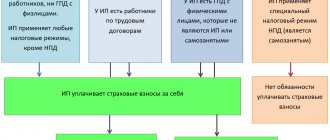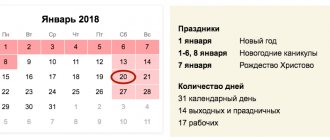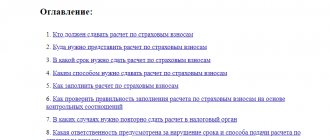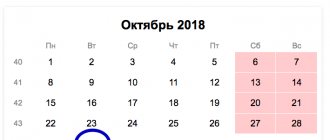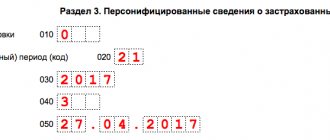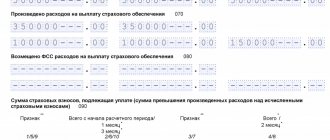- home
- Reference
- Insurance premiums
In essence, any individual entrepreneur creates a workplace for himself. Business profits are equal to personal income. But there are still factors that anyone can face - temporary disability, illness or old age. The same applies to motherhood and the need to care for sick children.
We will discuss in the article whether it is necessary to submit calculations for insurance premiums to individual entrepreneurs without employees.
Should you report or not?
Calculation of insurance premiums for employees is also referred to as DAM. The document became mandatory for registration starting in 2017. A corresponding chapter was added to the Tax Code, which describes accrual and payment and other important nuances.
The rules for filing reports and their execution state that these actions have become mandatory for citizens of the following categories:
- Individuals who pay remuneration to others, but do not themselves belong to.
- Individual entrepreneurs.
- Citizens with the status of legal entities.
The situation is slightly different for individual entrepreneurs who do not hire employees at all. According to the current law, all such citizens can be divided into two categories. These are those who calculate payments to employees, or those who do everything only for themselves. In the first case, we are talking about the category of policyholders, so filling out calculations becomes a mandatory requirement.
The latter will also be insured, but only for themselves. If there are no employees, there should be no calculations for insurance premiums. But there are situations when the requirement still comes into force.
Who should submit the report?
The obligation to submit reports from an entrepreneur without employees is removed. But there is a high probability that regulatory authorities will require additional clarification.
In any case, it must be reported separately that the subject simply does not have hired force. A zero report is always submitted, even when there are workers, but they are not continuing to work and are temporarily absent from the site. Document samples help you understand the filling rules.
Do they give zero calculation?
Individual entrepreneur reporting on the simplified tax system - what and when needs to be submitted using a simplified procedure
Such forms are submitted in any case, regardless of whether the main activity was carried out or not.
The calculation of salaries and other similar remunerations also does not matter. The obligation to provide DAM is not relieved even if the duties of the general director are assigned to the sole owner, without an employment contract. And even when the individual entrepreneur simply does not have any other employees. Section 3 of the report described above simply provides personal information about the CEO.
Rules for document execution
It is required to use a new form with a separate designation - KND 1151111. The form is filled out for all employees. The document contains the following types of information:
- Personal data for all persons who were insured. We need the addresses where they live and are registered, TIN.
- Information regarding who acts as the payer of insurance premiums. This type of payment is considered separately.
- Description of the same obligations, only for peasant farms.
- Description of an individual who does not have the status of an individual entrepreneur. It must be contributed by everyone who operates in the current market.
Attention! The paper version of registration and submission is chosen in most cases.
Due dates
Calculation of insurance premiums is classified as a quarterly type of document. Usually we are talking about the following periods of time:
- Year.
- 9 months.
- Half year.
- 1st quarter. In this case, it is always necessary to transfer documents.
Until the 30th day of the month following the reporting period is the maximum period for which regulatory authorities must receive information. If the delivery day falls on a holiday or weekend, you can postpone the date until the next working day. It is acceptable to use paper and electronic media equally.
Reference! Information is provided during a personal visit or via email. Both options are acceptable. The responsible employee may suffer if at least part of the information is lost.
Legal regulation of individual entrepreneur reporting.
1.1 Individual entrepreneur submission of financial statements
From the point of view of legislation, individual entrepreneurs may not keep accounting records (Federal Law No. 402-FZ “On Accounting”). Sometimes an individual entrepreneur may be asked to provide financial statements. For example, when an individual entrepreneur wants to receive a bank guarantee.
If an individual entrepreneur does not keep financial statements and does not plan to do so, our advice is to agree with the bank that instead of financial statements only tax reporting will be provided.
1.2. General taxation system, Unified Agricultural Tax
If an individual entrepreneur did not have time (did not want) to submit a notice of transition to one of the simplified regimes, then it is considered that he applies the general taxation system. He will have to submit a VAT return quarterly and a personal income tax return once a year. Also, once a year a declaration under the Unified Agricultural Tax is submitted.
1.3. simplified tax system
Tax reporting under the simplified tax system (tax return under the simplified tax system) is annual, the deadline for submitting individual entrepreneurs’ reports for the year is until April 30 of the next year. According to the directions of tax policy for 2021 - 2022, individual entrepreneurs simplified tax system Income (6%) who use online cash registers in their work will be exempt from filing a Declaration under the simplified tax system. The timing of the changes has not yet been determined.
1.4. UTII
Tax returns for UTII are submitted quarterly. Here we must take into account that from 2021 those who sell goods subject to labeling (medicines, shoes and some others) cannot apply. And from 2021, UTII as a tax regime has been completely abolished.
1.5. PSN, self-employed
First, about the terms. The patent tax system (PTS) is sometimes called a patent for simplicity. The self-employed in 2021 are those who have switched to paying professional income tax (PIT). Neither one nor the other submits any declarations for their main tax.
1.6. Individual entrepreneurs submitting reports on insurance premiums and personal income tax
Such reporting is submitted only by those individual entrepreneurs who have employees. If you have the situation “IP employee”, then give up:
- in the Pension Fund of the Russian Federation monthly information in the form SZV-M and SZV-TD, and once a year calculation of SZV-experience.
- to the FSS of the Russian Federation quarterly report 4-FSS,
- The Federal Tax Service submits quarterly calculations for insurance premiums and 6-personal income tax, and for the year also 2-personal income tax. Starting next year, most likely, 6-NDFL and 2-NDFL will be combined into one report (there is a project).
Penalty for late reporting
Fines apply even to companies that do not have employees or work at the moment. The penalties are described as follows:
- If there is no report - a fine of 1000 rubles.
- 300-500 rubles is a punishment for administrative persons on whose part violations are detected.
- Transactions on bank cards and accounts are suspended. If the shortcomings are eliminated, then the situation is corrected.
- 200 rubles when only some registration rules are not followed.
What other calculation features are worth remembering?
Previously, such calculations were based only on information regarding profits. Now we are talking about the income received. The main thing is not to confuse the concepts with each other. The following types of income can be classified as income, depending on the chosen tax regimes:
- The amount of profit based on the relevant document when the patent system is applied. All receipts are based on existing documentation.
- With UTII, the income previously imputed for the year is summed up. Indicators from lines 100 are added up for the last several reporting periods.
- Under the simplified tax system, the amount also includes the so-called non-operating profit. For example, when payments for rent of premises are received. Such indicators are prohibited from being reduced by the amount of costs. This also applies to cases where the appropriate regime is used. This scheme does not apply only in the case of social payments.
- For OSNO, everything that is included in standard documents is taken into account.
If there is a single founder, then he is also considered the general director. It is he who receives the salary along with other forms of remuneration. And in this case, he is listed in the compulsory insurance system. Data is still transmitted to Federal Tax Service employees, albeit in a minimal form.
Important! All lines in the document are filled in, but only one person will be the recipient of the payment.
When completing zero calculations, the following components must be filled out:
- Title page.
- The first section, where the company that pays the insurance premiums describes its data.
- Second application.
- Third section.
All lines indicate the number 0 when there are no numerical indicators.
After receiving the documents, the tax service will organize a desk audit. Explanations are requested if any errors or inaccuracies are identified. The response must be sent within a maximum of 5 working days.
If there is no response, a fine of up to 5 thousand rubles may be imposed. Repeated violations result in the fine increasing to 20 thousand rubles.
The document is transferred even if all employees go on vacation at their own expense. The design is not much different from the standard rules outlined above. The obligation is completely lifted only from employers who have never been officially registered in the system.
Problems arise if at first there were employees, but then the relationship with them was broken, after which the citizen again works alone. If a citizen is not deregistered, there is a high probability of additional claims from regulatory authorities.
Insurance premiums “for yourself”
Basic concepts about contributions
Contributions consist of two parts:
- Fixed insurance premiums for individual entrepreneurs are paid by the vast majority of entrepreneurs - for compulsory health insurance (pension insurance) and compulsory medical insurance (medical insurance).
- 1% “from excess” - paid only on income over 300,000 rubles. per year, credited to the OPS.
The maximum insurance premium for compulsory health insurance for the year cannot exceed 8 times the size of the fixed premium for compulsory health insurance. Contributions to compulsory pension insurance form the future pension of an individual entrepreneur, adding length of service and points for retirement.
Contributions in 2021, 2022 and 2023
In 2021, the amount of insurance premiums is not indexed and remains the same as in 2021. And from 2022, contributions will increase again. See the plate for exact dimensions.
| Contributions to compulsory pension insurance (OPI) | Contributions to compulsory health insurance (FFOMS) | Total contributions | |
| 2020 | 32,448 + 1% max. 259 584 | 8 426 | 40 874 + 1% |
| 2021 | 32,448 + 1% max. 259 584 | 8 426 | 40 874 + 1% |
| 2022 | 34,445 + 1% max. 275 560 | 8 766 | 43 211 + 1% |
| 2023 | 36,723 + 1% max. 293 824 | 9 119 | 45 842 + 1% |
Example:
In 2021, the individual entrepreneur earned 2 million rubles. We will calculate insurance premiums.
- Fixed part: 40874 rub.
- 1% from excess: (RUR 2,000,000 – RUR 300,000) x 1% = RUR 17,000
Total amount of insurance premiums: 57,874.
Income for calculating 1% from excess
The calculation of income directly depends on the taxation system applied:
- STS 6% - fully received income is taxed (taking into account the maximum contribution amount).
- STS 15% - income received minus expenses is taxed.
- UTII - only imputed income is taxed.
- Patent - only potential income is taxed.
- BASIC - income is taken minus expenses as for personal income tax.
- Unified agricultural tax - take real income without taking into account expenses.
If you combine several tax regimes, the indicated income will have to be added up.
Grace periods
An individual entrepreneur who does not operate may reduce or not pay contributions if:
- served in the army by conscription;
- was on maternity leave for up to 1.5 years;
- cared for a disabled person (the period of care is established by a decision of the Pension Fund);
- left with a spouse in the military or with a spouse working in a certain organization (consulates, UN, UNESCO, etc.) and there is no opportunity to work there.
To confirm the benefit, it is necessary to collect supporting documents, such as: a certificate of receipt of child care benefits, a military ID, written confirmation of a disabled person about his care, an extract from the certificate of examination of a disabled person, a certificate from a military unit, a certificate from the employment service and the like .
The benefit for reducing insurance premiums for individual entrepreneurs is valid only if no activity is carried out during the grace period and a “zero” declaration is submitted.
Payment of insurance premiums
Contributions for individual entrepreneurs without employees are paid to the tax office:
- fixed - no later than December 31 of the corresponding year (and if it falls on an official non-working day, then no later than the first working day)
- 1% - no later than July 1 of the next year (a similar rule with a non-working day)
Individual entrepreneurs have the right to pay contributions throughout the year in installments, or the entire amount one-time.
Example:
Contributions for 2021 are paid:
- fixed - until December 31, 2021 inclusive
- 1% - no later than July 1, 2021.
Current BCCs can be viewed on the tax office website. A payment order for taxes can be filled out through the Federal Tax Service website
If the individual entrepreneur has been working for less than a year
If a person registered as an individual entrepreneur in the middle of the year or, conversely, deregistered, or there were grace periods, contributions are calculated only for the period of activity as an individual entrepreneur. For each full month - in the amount of 1/12 of the tariff. In partial months - in proportion to the number of calendar days worked.
Example
: IP registration date - October 23, 2021. Income - 400,000 rubles.
Fixed payment for pension insurance:
- 32 448/12 = 2 704
- (2,704 x 2 months + 2,704 x 9 days / 31 days) = 6,193.03
Fixed payment for health insurance:
- (8,426 / 12 months x 2 months + 8,426 x 9 days / 366 days) = 1,611.53
1% from excess
- (400,000 - 300,000) x 1% = 1,000
Total for 2021: 6 193,03 + 1 611,53 + 1 000 = 8 804,56
Voluntary insurance
An entrepreneur can voluntarily insure himself with the social insurance fund. Then he will have the right to sick pay and maternity benefits. If someone plans to go on maternity leave in 2021, then in order to receive benefits they should register with the fund and pay an annual contribution of 4,221.24 rubles by December 31, 2021.
The amount of sick leave and maternity benefits will be calculated at the minimum rate based on the minimum wage on the day the insured event occurs.
Accountability for yourself
There is no reporting for mandatory personal contributions. Individual entrepreneurs do not report on voluntary contributions to the Social Insurance Fund.
